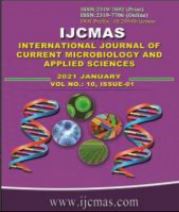


 National Academy of Agricultural Sciences (NAAS)
National Academy of Agricultural Sciences (NAAS)

|
PRINT ISSN : 2319-7692
Online ISSN : 2319-7706 Issues : 12 per year Publisher : Excellent Publishers Email : editorijcmas@gmail.com / submit@ijcmas.com Editor-in-chief: Dr.M.Prakash Index Copernicus ICV 2018: 95.39 NAAS RATING 2020: 5.38 |
Surgical site infections (SSI) continue to be a major problem among the hospital acquired infections. Among the pathogens Staphylococcus aureus (S. aureus) is known to cause SSI since many decades. SSI caused byMethicillin resistant Staphylococcus aureus (MRSA) has become an obstacle in the clinical outcome of patients undergoing surgery. SSI not only affects the patient’s outcome but also increases the burden to the hospital,hence the present study was conducted to know the prevalence of MRSA causing surgical site infection and to know the antibiotic susceptibility pattern of the S. aureus causing surgical site infection. This study was conducted during June 2015 to May 2016, during which 140 samples were collected of whichE. coli (32.6%) was the most common pathogen causing SSI followed by S. aureus (18.1%). Prevalence of MRSA causing SSI is 13.6%. Most of the isolates were resistant to commonly used antibiotics and choice of antibiotics for treatment were Amoxicillin-clavulanate, Imipenem, Meropenem and Linezolid. MRSA causing SSI continues to be a major challenge for treating surgeons, hence regular screening of health care workers to identify MRSA carriers, strict adherence to preventive measures during preoperative, operativeand postoperative period and meticulous infection prevention control practices are the needed to bring down the SSI rates.
 |
 |
 |
 |
 |